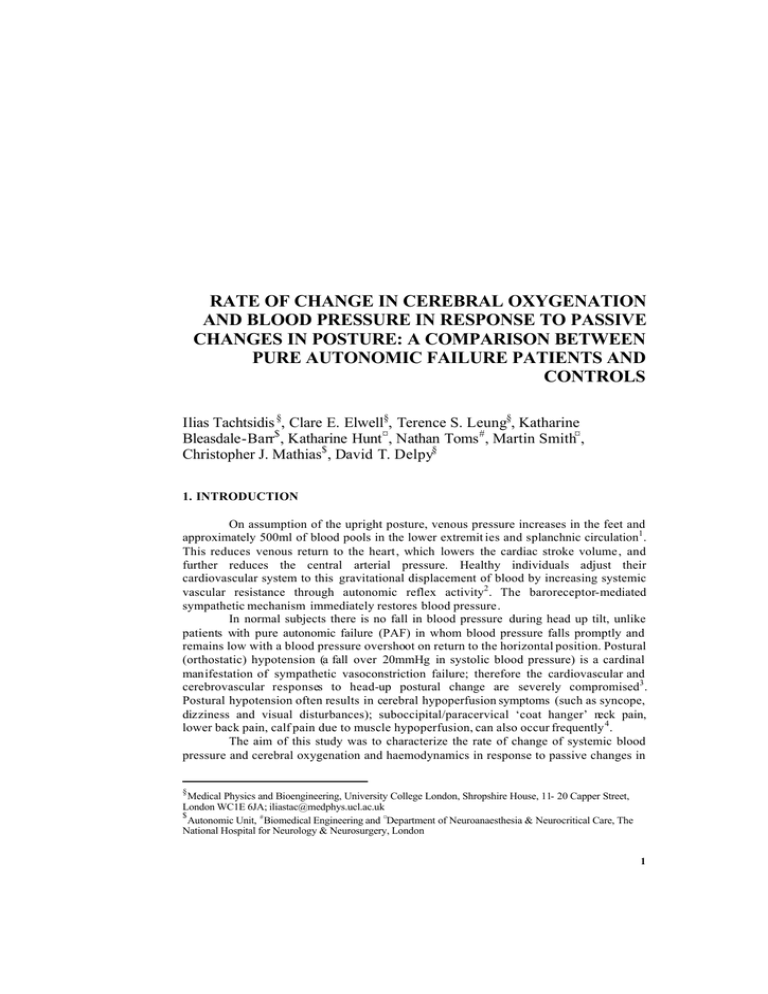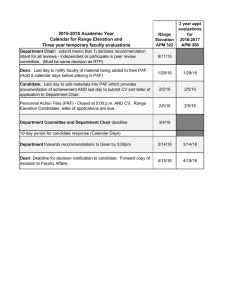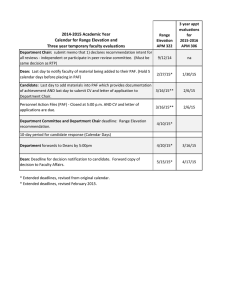RATE OF CHANGE IN CEREBRAL OXYGENATION
advertisement

RATE OF CHANGE IN CEREBRAL OXYGENATION AND BLOOD PRESSURE IN RESPONSE TO PASSIVE CHANGES IN POSTURE: A COMPARISON BETWEEN PURE AUTONOMIC FAILURE PATIENTS AND CONTROLS Ilias Tachtsidis §, Clare E. Elwell§, Terence S. Leung§, Katharine Bleasdale-Barr$ , Katharine Hunt ¤ , Nathan Toms # , Martin Smith¤ , Christopher J. Mathias$ , David T. Delpy§ 1. INTRODUCTION On assumption of the upright posture, venous pressure increases in the feet and approximately 500ml of blood pools in the lower extremit ies and splanchnic circulation1 . This reduces venous return to the heart, which lowers the cardiac stroke volume, and further reduces the central arterial pressure. Healthy individuals adjust their cardiovascular system to this gravitational displacement of blood by increasing systemic vascular resistance through autonomic reflex activity2 . The baroreceptor-mediated sympathetic mechanism immediately restores blood pressure. In normal subjects there is no fall in blood pressure during head up tilt, unlike patients with pure autonomic failure (PAF) in whom blood pressure falls promptly and remains low with a blood pressure overshoot on return to the horizontal position. Postural (orthostatic) hypotension (a fall over 20mmHg in systolic blood pressure) is a cardinal manifestation of sympathetic vasoconstriction failure; therefore the cardiovascular and cerebrovascular responses to head-up postural change are severely compromised3 . Postural hypotension often results in cerebral hypoperfusion symptoms (such as syncope, dizziness and visual disturbances); suboccipital/paracervical ‘coat hanger’ neck pain, lower back pain, calf pain due to muscle hypoperfusion, can also occur frequently 4 . The aim of this study was to characterize the rate of change of systemic blood pressure and cerebral oxygenation and haemodynamics in response to passive changes in § Medical Physics and Bioengineering, University College London, Shropshire House, 11- 20 Capper Street, London WC1E 6JA; iliastac@medphys.ucl.ac.uk $ Autonomic Unit, # Biomedical Engineering and ¤Department of Neuroanaesthesia & Neurocritical Care, The National Hospital for Neurology & Neurosurgery, London 1 2 I. TACHTSIDIS ET AL. posture in patients with PAF and healthy age matched controls. Here we provide a template that fully describes the pattern of changes seen in the systemic and cerebral haemodynamics during a passive tilt protocol. In 1997 Colier et al5 identified a similar pattern of the rate of change in cerebral haemodynamics in a group of healthy and hypovolaemic volunteers during passive tilt. We extend this work by more fully characterizing the patterns seen in a PAF patient group compared to the healthy controls. 2. METHODS 2.1 Participants 9 PAF patients of mean age 61±7 years and 9 age matched healthy volunteers with mean age 62±7 years took part in this study (the local ethics committee approved the protocol for the study, and all subjects gave informed consent for participation). Pure autonomic failure is one clinical classification of primary chronic autonomic failure, and was formerly known as ‘idiopathic orthostatic hypotension’6 . The PAF patients studied here did not have any associated neurological disorders or any signs of central nervous system lesions. 2.2 Measurements A continuous wave near-infrared spectrometer (NIRS), with a sampling rate of 6Hz (NIRO 300, Hamamatsu Photonics KK) was used to measure absolute cerebral tissue oxygenation index (TOI) over the frontal cortex using the spatially resolved reflectance spectroscopy technique7 , together with changes in oxy-haemoglobin (∆[O2 Hb]) and deoxy -haemoglobin (∆[HHb]) by utilizing the modified Beer-Lambert law8 . The probe was placed on the forehead (taking care to avoid the midline sinuses) and was shielded from ambient light by using an elastic bandage and a black cloth; the studies took place in a darkened room. An optode spacing of 5 cm was used and optical filters were also used where necessary to optimise signal to noise ratio. The differential pathlength factor (DPF) was calculated for each subject using the age dependence equation 9 : DPF780 = 5 .13 + 0. 07 A 0y .81 where DPF780 is the DPF at 780nm and A y is the age of the subject in years. A Portapres® system (TNO Institute of Applied Physics, Biomedical Instrumentation) was used to continuously and non-invasively measure blood pressure from the finger. The mean blood pressure (MBP) data was collected to a PC via a serial link at 100 Hz sampling rate and was later resampled to 6 Hz. 2.3 Protocol Each subject was strapped on an electrical moving tilt table and underwent three postural changes. After an initial 10 minutes resting period in the supine position, the subject was tilted upright to an angle of 60° for another 10 minutes and then returned to the supine position for an additional 10 minutes. Head up tilt was interrupted if severe symptoms of orthostatic intolerance occurred, whereupon the patient was immediately RATE OF CHANGE IN CEREBRAL OXYGENATION AND BLOOD PRESSURE 3 returned to the supine position. The tilting movement process was performed via an electrical motor and lasted 6 seconds for both the up and down movements. 2.4 Signal Analysis The NIRS and blood pressure data were low pass filtered (cut-off frequency 0.2Hz) to remove respiratory noise; additionally a Savitsky-Golay filter (a 10sec moving 2nd order polynomial) was used to further smooth the data. From visual inspection of the haemoglobin difference (∆[Hb diff ]) signal (derived by subtracting ∆[O2 Hb] from ∆[HHb]), total haemoglobin (∆[HbT]) signal (derived from adding ∆[O2 Hb] to ∆[HHb]), TOI signal and MBP signal, distinct phases were recognized and marked. For each phase the slope was calculated using a linear regression algorithm. Figure 1 shows an illustration of the pattern seen in the ∆[Hb diff ] signal. Haemoglobin Difference (∆[ Hb diff]=∆ [O2Hb]-∆ [HHb]) PAF 7 1 0 6 2 5 3 Syncope 4 4b Controls 7 6 1 0 2 5 3 4 Supine Tilt-Up 4min 5-10min Supine 4min Figure 1. A schematic representation of the pattern seen in the signals. During Phase 1 the subject lies supine resting, when tilt begins there is a passive circulatory response recognised as phase 2, this leads to phase 3 during which any active vascular control mechanisms kick in; the head-up posture finishes with phase 4, except in a symptomatic patient who exhibits a further fall (phase 4b). Tilt reversal starts with a fast passive response, shown as phase 5 that leads to phase 6, which demonstrates the hyperaemia effect and finally phase 7, a recovery to baseline which marks the end of the experiment. For clarity only the ∆[Hbdiff] is displayed. Not all the subjects clearly showed all the phases, so data from missing phases has been excluded from the group analysis (see Tables 1 and 2). Direct comparison of the magnitude of the slopes between the PAF patients and the controls was then performed for each signal using a student t-test. Table 1. Number of subjects in which each phase was clearly detected. Number of subjects (Controls/PAF) for each phase. Hbdiff HbT TOI MBP Phase 1 9/9 9/9 9/8 9/9 Phase 2 6/9 8/9 6/8 9/9 Phase 3 9/9 8/9 8/8 3/8 Phase 4 9/9 9/9 9/7 9/9 Phase 5 9/9 9/9 9/7 9/9 Phase 6 6/9 8/7 4/5 2/9 Phase 7 9/9 9/9 9/7 9/9 I. TACHTSIDIS ET AL. 4 Table 2. The number of phases seen in every subject for each signal. Number of phases seen in each subject. Controls Hbdiff HbT TOI MBP Patients Hbdiff HbT TOI MBP Control 1 7 7 6 7 PAF 1 7 7 7 7 Control 2 7 6 6 5 PAF 2 8 8 7 7 Control 3 7 7 7 5 PAF 3 7 7 7 7 Control 4 7 7 7 5 PAF 4 7 7 7 7 Control 5 7 7 7 6 PAF 5 7 5 3‡ 7 Control 6 5 7 5 6 PAF 6 7 7 NA† 7 Control 7 7 7 7 6 PAF 7 8 8 7 6 Control 8 5 7 5 5 PAF 8 7 7 7 7 Control 9 5 5 5 5 PAF 9 7 6 7 7 ‡ Patient hyperventilated when head up, this affected the TOI measurements therefore data after this was excluded. † The TOI measurement was contaminated by artifact therefore the TOI data from this patient was excluded. 3. RESULTS 3.1 MBP Using an unpaired t-test s ignificant differences were found in the magnitude of slopes between PAF and healthy controls for phase 2 (p<0.01) and phase 5 (p<0.01) (see Figure 2A). 3.2 NIRS signals Using an unpaired t-test significant differences were found in the ∆[Hb diff] slope magnitudes between PAF and healthy controls for phase 3 (p<0.05) and phase 5 (p=0.01) (see Figure 2B). Also there was significant difference in the duration of phase 2 (p<0.05), as PAF patients demonstrated a longer period (n=9, period=47.7±16.6 sec) than healthy controls (n=6, period=29.9±14.6 sec). No significant differences were found in the magnitude of slopes and the periods for the ∆[HbT] and the TOI. A B Magnitude of MBP Slopes Magnitude of Hb diff Slopes 0.35 1.25 0.3 0.25 0.5 Controls PAF 0.25 0 -0.25 0 4 8 12 -0.5 16 20 24 H b diff (umolar / sec) MBP (mmHg / sec) 1 0.75 0.2 0.15 0 -0.05 0.0 -0.75 Controls PAF 0.1 0.05 2.5 5.0 7.5 10.0 12.5 15.0 17.5 20.0 22.5 -0.1 -1 -0.15 Time (minutes) Time (minutes) Figure 2. PAF patients versus healthy controls A: Magnitude of MBP slopes with mean time, B: Magnitude of ∆[Hbdiff] slopes with mean time. RATE OF CHANGE IN CEREBRAL OXYGENATION AND BLOOD PRESSURE 5 4. DISCUSSION This study provides a comprehensive template for the cerebral oxygenation, cerebral haemodynamics and blood pressure changes with time, during head-up tilt in both PAF patients and healthy age matched controls. We demonstrated that there were significant differences in the rate of change of ∆[Hb diff] and blood pressure between PAF and healthy controls. The rate of changes in ∆[HbT] and TOI did not demonstrate significant differences presumably due to large individual subject variability and the small group numbers. In the healthy controls, during head-up tilt the cardiovascular responses were consistent with sympathoneural activation in response to gravitational stress, leading to a rise in MBP; this was seen as a rapid positive phase 2 (n=9, slope=0.28±0.14 mmHg/sec). These results are in agreement with other studies in normal humans, reporting activation of compensatory mechanisms that maintain blood pressure when upright. In the PAF patients , head-up tilt caused a fall in MBP seen as a large negative phase 2 (n=9, slope=0.85±0.4 mmHg/sec), leading to substantial postural hypotension. In the healthy controls, following tilt reversal, MBP returned promptly although not entirely to pre-tilt levels exhibiting a very high negative phase 5 (n=9, slope=-0.46±0.46 mmHg/sec). In the PAF group blood pressure promptly rose settling slightly higher than the pre-tilt levels and exhibiting a larger absolute slope magnitude of phase 5 fro m the controls (n=9, slope=1±0.46 mmHg/sec). The change in arterial blood pressure in healthy volunteers is a consequence of continuous changes in the activity of the nerves to the systemic resistance blood vessels; this involves a set of complex adjustments to maintain arterial blood pressure so as to ensure adequate perfusion of vital organs, including the brain. In this study we used an NIRS system to interrogate the brain and provide information on cerebral haemodynamics and oxygenation. ∆[Hb diff ]can be used as an indicator of oxygenation by looking for any mismatch between oxygen demand and oxygen supply. Following the orthostatic hypotension, PAF patients exhibit symptoms of cerebral hypoperfusion, which often leads to syncope. ∆[Hb diff ] signal falls quite rapidly immediately following the head-up tilt and continues to fall after the transition as demonstrated in the magnitude of phase 3 (n=9, slope=0.03±0.01 µmolar/sec); this is not seen in the healthy controls as during phase 3 the rate of change has reach a steady state (n=9, slope=-0.009±0.02 µmolar/sec), which indicates a completed circulation compensation. On tilt reversal, recognised as phase 5, there is a return of peripherally pooled blood and fluid into the central vascular comp artment and head. The recovery phase 5 also demonstrates the inability of the PAF patients to control their vasculature from the passive changes , exhibiting a large positive slope that leads to hyperaemia (n=9, slope=0.29±0.2 µmolar/sec); once again this was not observed in the healthy controls (n=9, slope=0.07±0.05 µmolar/sec). The mechanism that controls peripheral resistance and hence the rate of change in blood flow and oxygenation is the sympathetic system, which is absent in PAF patients who lack the ability to regulate their systemic and cerebral vasculature. Further evidence to support this was found when investigating the periods of each ∆[Hb diff] phase. There were significant differences during phase 2, which represents the passive circulatory response immediately after the start of the tilt; PAF patients demonstrated a longer period (n=9, period=47.7±16.6 sec) than healthy controls (n=6, period=29.9±14.6 sec). During the initial stage of tilt the 6 I. TACHTSIDIS ET AL. effective peripheral vascular resistance of the lower body is low and blood flow to the lower limbs increases. The sympathetic system, which clearly responds in the healthy controls regulates blood pressure and limits the pooling of blood to the lower extremities. The most striking difference in the NIRS measurements between the PAF and healthy controls was found in ∆[Hb diff ]; ∆[HbT] and TOI did not show any significant differences. ∆[HbT] can be used as an indicator of blood volume and TOI, which is the ratio of ∆[O2 Hb] to ∆[HbT], indicates the balance between oxygen delivery and tissue oxygen consumption. ∆[HbT] and TOI rate of change did not reach significance for either phase 3 (p=0.054 and p=0.056 respectively) or phase 5 (p=0.1 and p=0.099 respectively). This may be due to the small group numbers and the large inter-subject variability of these measurements. In a recent study Al-Rawi et al10 measured haemoglobin concentrations and TOI during carotid surgery and showed that the sensitivity of TOI to intracranial changes was 87.5% with a specificity of 100%. This raises confidence in assuming that TOI reflects changes in cerebral oxygenation, however TOI is also affected by the arterial:venous volume ratio, which may change significantly during these tilt studies. In this study we have provided a template for investigating the rate of change of the systemic and cerebral effects of posture change in PAF and healthy age matched controls. Given the wide range of conditions and symptoms related to autonomic failure it is suggested that this template will be of use in describing the neurophysiology of these groups with studies on sufficient number of patients. ACKNOWLEDGMENTS The authors would like to thank all the volunteers who participated in this study and Hamamatsu Photonics KK for providing the NIRO 300 spectrometer. This work was supported by the EPSRC/MRC, grant No GR/N14248/01 (IT) and the Wellcome Trust grant No GR/062558 (TSL). REFERENCES 1. M. Lye, T. Walley, Haemodynamic responses in young and elderly healthy subjects during ambient and warm head-up tilt, Clinical Science, 94, 493-498 (1998). 2. C. J. Mathias, Orthostatic hypotension: causes mechanisms and influencing factors, Neurology, 45(S5), S6 S11 (1995). 3. C. J. Mathias, R. Bannister, in: Autonomic Failure A textbook of clinical disorders of the autonomic nervous system , edited by C. J. Mathias, R. Bannister (Oxford Medical Publications, 2002), pp. 169-195. 4. C. J. Mathias, R. Mallipeddi, K. Bleasdale-Barr, Symptoms associated with orthostatic hypotension in pure autonomic failure and multiple system atrophy. Journal of Neurology, 246, 893-898 (1999). 5. W. N. J. M. Colier, R. A. Binkhorst, M. T. E. Hopman, B. Oeseburg, Cerebral and circulatory haemodynamics before vasovagal syncope induced by orthostatic stress, Clinical Physiology, 17, 83-94 (1997). 6. R. Bannister, C. J. Mathias, in: Autonomic Failure A textbook of clinical disorders of the autonomic nervous system , edited by C. J. Mathias, R. Bannister (Oxford Medical Publications, 2002), pp. 307-316. 7. S. Suzuki, S. Takasaki, T. Ozaki, Y. Kobayashi, A tissue oxygenation monitor using NIR spatially resolved spectroscopy, Proc SPIE, 3597, 582-592 (1999). 8. D. T . Delpy, M. Cope, Quantification in tissue near-infrared spectroscopy, Philosophical Transactions of the Royal Society of London Series B-Biological Sciences, 352(1354), 649-659 (1997). 9. A. Duncan, J. H. Meek, M. Clemence, C. E. Elwell, P. Fallon, L. Tyszczuk, M. Cope, D. T. Delpy, Measurement of cranial optical path length as a function of age using phase resolved near infrared spectroscopy, Pediatric Research, 39(5), 889-894 (1996). 10. P. G. Al-Rawi, P. Smielewski, P. J. Kirkpatrick, Evaluation of a near-infrared spectrometer (NIRO 300) for the detection of intracranial oxygenation changes in the adult head, Stroke, 32, 2492-2500 (2001).


